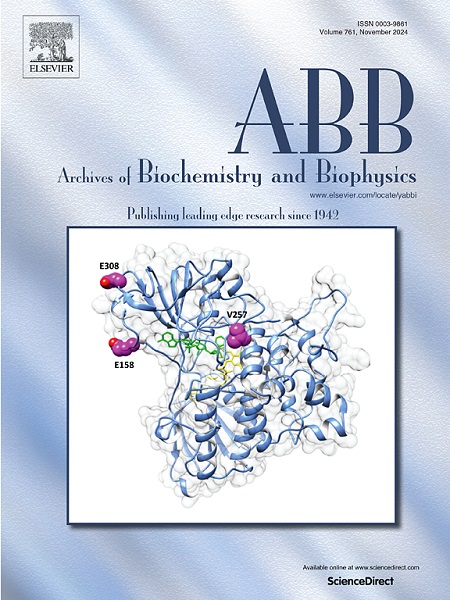The primary studies of epigallocatechin-3-gallate in improving brain injury induced by chronic high-altitude natural environment in rats by 7.0T high-field MR imaging
IF 3.8
3区 生物学
Q2 BIOCHEMISTRY & MOLECULAR BIOLOGY
引用次数: 0
Abstract
Background
Epigallocatechin-3-gallate (EGCG) is one of the most abundant and important bioactive polyphenolic compounds in green tea. However, despite its potent antioxidant effects, its neuroprotective effects on chronic high altitude (HA)-induced nerve damage have not been reported. The purpose of this study is to use quantitative susceptibility mapping (QSM) with pathology to dynamically evaluate the status of brain damage and the effect of EGCG.
Methods
A model of HA environments-induced brain injury was established of Sprague-Dawley (SD) rats in a natural plateau environment for 4 weeks, 8 weeks, 12 weeks and 20 weeks. Behavioral alterations were then observed and assessed with the open field test (OFT) and Morris water maze (MWM) test. The microglial activation, nissl staining and neural degeneration by Fluoro Jade B in the hippocampus of the rats were observed by immunohistochemistry. In the rats, serum erythropoietin (EPO), hippocampal inflammatory cytokines (interleukin-1β [IL-1β], interleukin-6 [IL-6] and tumor necrosis factor-α [TNF-α]), ferritin, oxidative stress (superoxide dismutase [SOD], glutathione peroxidase [GSH-Px], catalase [CAT] and malondialdehyde [MDA]) were detected using ELISA kits and biochemical methods. Iron accumulation was observed by QSM and colorimetry. Iron metabolisms (ceruloplasmin [Cp], transferrin [Tf], divalent metal transport1 [DMT1] and hepcidin [Hep]) were detected using qPCR. Neural ultrastructural changes were evaluated with electron microscope. Salidroside treatment was chosen as the positive control group in ELISA, biochemical detection and electron microscopy.
Results
The susceptibility values in the left and right hippocampus, the hippocampal ferritin, serum and hippocampal iron content increased significantly after HA exposure. The expression of hippocampal Cp and Hep decreased and the expression of Tf increased. Nissl staining revealed that the neurons of hippocampal CA1 region of h-20w group were small and irregular, atrophied, and nuclear shrinkage. Tissue oxidative stress and inflammatory indicators (MDA, TNF-α, IL-1β, IL-6) increased while antioxidant enzymes (SOD, CAT, GSH-Px) decreased. EGCG attenuated HA environments-induced cognitive impairment, iron accumulation, microglial activation and neural degeneration. The effects of EGCG in reducing EPO and the metal chelating property with respect to iron were dose-dependent, with effects of EGCG (50 mg/kg) being similar to those of salidroside (50 mg/kg).
Conclusions
EGCG can act as a neuroprotective agent against chronic HA environments-mediated neural injuries. QSM provides a potential complementary imaging technique to detect the effect of treating HA diseases.

表没食子儿茶素-3-棓酸盐通过 7.0T 高场磁共振成像对改善大鼠在长期高海拔自然环境中引起的脑损伤的初步研究。
背景:表没食子儿茶素-3-棓酸盐(EGCG)是绿茶中最丰富、最重要的生物活性多酚类化合物之一。然而,尽管表儿茶素具有强大的抗氧化作用,但其对慢性高海拔(HA)诱导的神经损伤的神经保护作用尚未见报道。本研究的目的是利用病理定量易感性图谱(QSM)动态评估脑损伤状况和EGCG的作用:方法:将Sprague-Dawley(SD)大鼠在自然高原环境中分别饲养4周、8周、12周和20周,建立HA环境诱导的脑损伤模型。然后通过开阔地试验(OFT)和莫里斯水迷宫试验(MWM)观察和评估大鼠的行为改变。通过免疫组化方法观察了大鼠海马的小胶质细胞活化、nissl染色和氟玉B神经变性。大鼠血清中的促红细胞生成素(EPO)、海马炎症细胞因子(白细胞介素-1β [IL-1β]、白细胞介素-6 [IL-6]和肿瘤坏死因子-α [TNF-α])、铁蛋白、氧化应激(超氧化物歧化酶)和神经变性、使用酶联免疫吸附试剂盒和生化方法检测氧化应激(超氧化物歧化酶[SOD]、谷胱甘肽过氧化物酶[GSH-Px]、过氧化氢酶[CAT]和丙二醛[MDA])。通过 QSM 和比色法观察铁的积累。使用 qPCR 检测铁代谢(脑磷脂蛋白 [Cp]、转铁蛋白 [Tf]、二价金属转运 1 [DMT1] 和肝素 [Hep])。用电子显微镜评估神经超微结构的变化。在 ELISA、生化检测和电子显微镜检查中,选择盐苷处理组作为阳性对照组:结果:暴露于 HA 后,左右海马的易感性值、海马铁蛋白、血清和海马铁含量均显著增加。海马Cp和Hep的表达量减少,Tf的表达量增加。Nissl染色显示,h-20w组海马CA1区神经元小而不规则、萎缩、核萎缩。组织氧化应激和炎症指标(MDA、TNF-α、IL-1β、IL-6)增加,而抗氧化酶(SOD、CAT、GSH-Px)减少。EGCG减轻了HA环境引起的认知障碍、铁积累、小胶质细胞活化和神经退化。EGCG降低EPO的作用和对铁的金属螯合作用与剂量有关,EGCG(50毫克/千克)与水杨甙(50毫克/千克)的作用相似:结论:EGCG 可作为一种神经保护剂,防止慢性 HA 环境介导的神经损伤。QSM为检测治疗HA疾病的效果提供了一种潜在的辅助成像技术。
本文章由计算机程序翻译,如有差异,请以英文原文为准。
求助全文
约1分钟内获得全文
求助全文
来源期刊

Archives of biochemistry and biophysics
生物-生化与分子生物学
CiteScore
7.40
自引率
0.00%
发文量
245
审稿时长
26 days
期刊介绍:
Archives of Biochemistry and Biophysics publishes quality original articles and reviews in the developing areas of biochemistry and biophysics.
Research Areas Include:
• Enzyme and protein structure, function, regulation. Folding, turnover, and post-translational processing
• Biological oxidations, free radical reactions, redox signaling, oxygenases, P450 reactions
• Signal transduction, receptors, membrane transport, intracellular signals. Cellular and integrated metabolism.
 求助内容:
求助内容: 应助结果提醒方式:
应助结果提醒方式:


